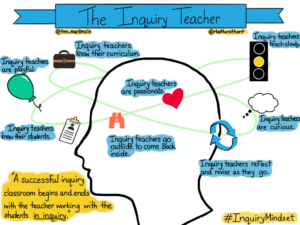Creating meaningful relationships with students and fostering collaboration and open communication is key for both online and in person learning. “One aspect of online teaching is fostering the perception by students that the instructor is present in the course” (Barnes, 201). I believe face to face interaction is so important in creating a sense of community and security online. By having virtual sessions it will allow teachers to find out the needs of their students (“What is Human-Centered Instruction”). In my Kindergarten class last year I showed my presence by creating morning messages, responding to students flipgrid videos, and holding weekly video chats. In my morning message I read a story, performed a magic trick and created a quick hands on math or English lesson. This message created a sense of normalcy for the students and allowed them to look forward to something every day. The virtual meeting allowed students to connect with their peers and share special events that had been going on in their life. I created fun team building activities for the students to do during these meetings; such as, go and find your favorite toy or find me 5 special items in your home. These activities allowed the students to connect with one another, and created a fun and engaging environment.
Another crucial aspect of online learning is creating a sense of belonging. “Dewey felt that teachers imposed too much control on students rather than being a part of the school community” ( (Barnes, 201)). I think it is important that we let our students know that they are valued and encourage them to express their ideas. I think we should showcase students’ talents and ask students to share their knowledge/skills with the class. For example, if a student is very knowledgeable on planets they could create a lesson or activity for the class and post it on flipgrid.
The image below showcases all of the components I deem important whether teaching online or in a classroom. The 3 points that stand out to me most are knowing your students, being playful and reflecting and revising as you go. As Barnes said “Frequent student-faculty contact in and out of classes is the most important factor in student motivation and involvement”. This can be done by hosting one on one video chats with students, creating team building activities, and starting an inquiry unit on the students and their families. Lastly, it is important to take time to reflect and ask for feedback from parents, students and colleagues. Every day I spend 15 minutes reflecting and I ask myself what went well, what didn’t go well, and what do I want to focus on tomorrow. These questions allow me to revise how I teach and provide me with a specific task or goal for each day.

References:
Barnes, C.L. (201). Where’s the Teacher ? Defining the Role of Instructor Presence in Social Presence and Cognition in Online Education. Humanizing Online Teaching and Learning. Retrieved from https://humanmooc.pressbooks.com/chapter/wheres-the-teacher-defining-the-role-of-instructor-presence-in-social-presence-and-cognition-in-online-education/
Howell Major, C. (2015). Teaching Online – A Guide to Theory, Research, and Practice. (Chapter 1). Retrieved from http://ebookcentral.proquest.com/lib/uvic/detail.action?docID=3318874
Hunt, R. B. (n.d.). Home. Retrieved September 26, 2020, from http://rebeccabathursthunt.com/sketchnotes/
What is Human-Centered Instruction? https://www.leadsv.com/hcn